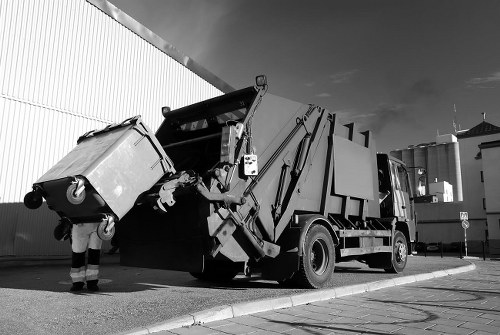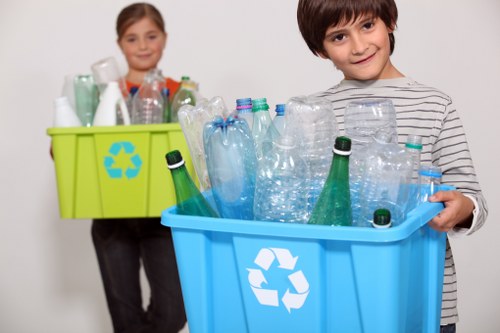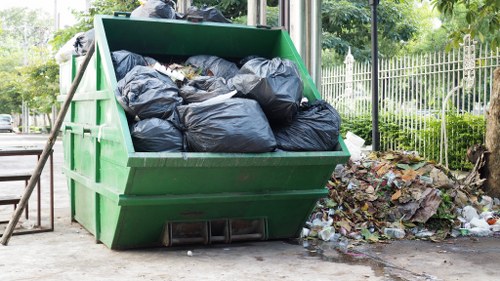Bed Disposal in Council Waste Collection
Understanding Bed Disposal

Disposing of old or unwanted beds can be a daunting task for many households. Whether you're upgrading your bedroom furniture or simply decluttering, knowing the proper way to dispose of a bed is essential. Improper disposal can lead to fines or environmental harm, making it crucial to follow local regulations.
Different components of a bed, such as the frame, mattress, and headboard, may require separate disposal methods. Understanding these nuances ensures that each part is handled responsibly and in accordance with council waste collection guidelines.
Moreover, recycling opportunities exist for certain bed materials, promoting sustainability and reducing landfill waste. By familiarizing yourself with these options, you can make eco-friendly choices when disposing of your bed.
Council Waste Collection Services

Council waste collection services vary by region, offering different options for bulky item disposal, including beds. Typically, local councils provide scheduled pickups for large items, but it's essential to check specific schedules and guidelines in your area.
Most councils require residents to book a special collection for bulky waste. This service may incur a fee, depending on the municipality and the number of items being disposed of. Planning ahead ensures a smooth disposal process without unnecessary delays.
In addition to pickups, some councils offer drop-off points where residents can bring their bulky waste. These centers are equipped to handle various large items, including furniture like beds, and often have specific hours for bulky waste disposal.
Preparation for Bed Disposal

Proper preparation is key to efficient bed disposal. Start by dismantling the bed frame and removing the mattress. Disassembling the bed not only makes it easier to transport but also ensures compliance with council requirements.
Separate recyclable materials such as metal frames or wooden parts from non-recyclable components. This segregation facilitates recycling processes and reduces the environmental impact of waste disposal.
Additionally, removing any personal items, bedding, or accessories from the bed before disposal is essential. Ensuring that the bed is free from clutter makes the collection process more straightforward for waste management services.
Recycling and Environmental Impact

Recycling parts of your bed can significantly reduce environmental impact. Metal frames can often be recycled, while wooden components may be repurposed or processed into mulch. Mattress recycling is also available in some areas, turning old mattresses into materials for construction or energy production.
By opting for recycling, you contribute to the conservation of resources and help minimize landfill usage. It's a sustainable approach that aligns with broader environmental goals and responsible waste management practices.
Moreover, recycling initiatives supported by councils often provide clear guidelines and resources to help residents participate effectively. Leveraging these programs ensures that your bed disposal aligns with eco-friendly standards.
Alternatives to Council Collection

If council waste collection isn't a feasible option, consider alternative disposal methods. Donation centers, charities, and second-hand stores may accept gently used beds, providing them with a new lease on life while benefiting those in need.
Online marketplaces offer platforms to sell or give away beds, connecting you with potential buyers or recipients in your community. This approach not only supports sustainability but also fosters a sense of community engagement.
For those who prefer not to donate, private waste removal services offer tailored solutions for bed disposal. While this option may incur additional costs, it provides flexibility and convenience, especially when dealing with oversized or specialized items.
Cost Considerations
Understanding the costs associated with bed disposal is crucial for budgeting and planning. Council collection fees vary based on location, the number of items, and the size of the bed. It's advisable to contact your local council to obtain accurate pricing information.
Alternative disposal methods may also involve costs. Private waste removal services typically charge based on the volume and weight of the items, while donation centers may offer free pickup services for qualifying items.
Considering the potential expenses associated with each disposal option allows you to make informed decisions that align with both your financial and environmental goals.
Legal and Safety Regulations
Compliance with Local Laws
Disposing of beds through council waste collection must adhere to local laws and regulations. Non-compliance can result in fines or other penalties, emphasizing the importance of understanding and following the prescribed guidelines.
Regulations may dictate the types of beds eligible for disposal, the scheduling of collections, and the methods of transportation. Familiarizing yourself with these laws ensures a hassle-free disposal process and avoids legal complications.
Failure to comply with local regulations can lead to environmental harm, exacerbating landfill issues and increasing pollution. Responsible disposal practices not only comply with the law but also contribute to community well-being.
Safety Precautions
Proper bed disposal involves adhering to safety precautions to prevent injuries and accidents. When dismantling a bed, use appropriate tools and protective gear to avoid injuries from sharp edges or heavy components.
Ensure that all parts are securely packaged or strapped during transportation to prevent damage or injury during handling. Secure packaging also facilitates efficient collection by waste management services.
Additionally, be mindful of any hazardous materials that may be part of the bed, such as springs or metal fittings. Proper handling and disposal of these components are essential for maintaining safety standards.
Benefits of Proper Bed Disposal
Environmental Benefits
Proper bed disposal significantly reduces the environmental footprint associated with waste. Recycling and responsible disposal minimize landfill usage, conserve natural resources, and decrease pollution levels.
By separating recyclable materials, you enable the reuse of valuable resources, fostering a circular economy that benefits both the environment and society.
Moreover, reducing the volume of waste contributes to mitigating climate change impacts by lowering greenhouse gas emissions from landfills.
Community Impact
Responsible bed disposal enhances community aesthetics and cleanliness, creating a more pleasant living environment. Properly managed waste disposal systems prevent unsanitary conditions and pest infestations associated with improper waste handling.
Furthermore, community participation in recycling and waste management initiatives fosters a culture of environmental stewardship and collective responsibility.
Active engagement in proper disposal practices strengthens community bonds and promotes sustainable living standards for future generations.
Tips for Efficient Bed Disposal
Plan Ahead
Effective bed disposal begins with careful planning. Assess the condition of your bed and determine the best disposal method based on its state and the materials it contains.
Scheduling your disposal in advance ensures timely collection and prevents accumulation of unnecessary waste in your living space.
Additionally, preparing all necessary information beforehand, such as dimensions and weight, facilitates a smoother disposal process.
Maximize Recycling Opportunities
Identify which parts of your bed can be recycled and take advantage of local recycling programs. Separating recyclable materials streamlines the process and supports sustainability goals.
Researching recycling facilities and understanding their requirements ensures that your bed components are processed correctly and efficiently.
Maximizing recycling efforts not only benefits the environment but may also reduce disposal costs by minimizing the volume of waste sent to landfills.
Utilize Professional Services
When in doubt, consider hiring professional waste removal services. Experts are equipped to handle large items safely and in compliance with local regulations.
Professional services offer convenience and efficiency, especially for complex or cumbersome disposal tasks that may be challenging to manage independently.
Leveraging professional assistance ensures that your bed disposal is executed seamlessly, reducing stress and minimizing potential errors.
Common Challenges and Solutions
Facing Size and Weight Constraints
Beds are often bulky and heavy, posing challenges for transportation and disposal. To overcome these hurdles, disassemble the bed into smaller components to facilitate easier handling.
Utilizing appropriate tools and equipment, such as screwdrivers and ramps, can aid in managing large parts effectively and safely.
Additionally, coordinating with waste collection services that have experience handling bulky items ensures that your bed disposal is managed proficiently.
Dealing with Restricted Items
Councils may have specific restrictions on the types of beds that can be disposed of through regular waste collection. For instance, beds containing hazardous materials or those in poor condition may require special handling.
In such cases, contacting the council for alternative disposal methods or seeking professional advice is essential to comply with regulations and ensure safety.
Understanding these restrictions beforehand prevents unexpected complications and facilitates a smoother disposal process.
Future Trends in Bed Disposal
Increased Recycling Initiatives
As environmental awareness grows, councils are expanding recycling initiatives to include more furniture items, including beds. This trend promotes sustainable waste management practices and encourages community participation.
Advancements in recycling technologies enable the efficient processing of various bed materials, making recycling a more viable and attractive option for residents.
The expansion of recycling programs reflects a broader commitment to reducing waste and promoting environmental responsibility.
Technological Innovations
Emerging technologies are revolutionizing bed disposal methods. Automated disassembly tools, real-time tracking of waste collection, and digital platforms for scheduling pickups enhance the efficiency and convenience of disposal services.
These innovations streamline the disposal process, making it more user-friendly and accessible to a wider audience.
Technological advancements also support better resource management, ensuring that recyclable materials are processed optimally and waste is minimized.
Conclusion
Proper bed disposal is a critical aspect of responsible waste management that benefits both individuals and the community. By understanding and adhering to council waste collection guidelines, residents can ensure their old beds are disposed of safely and sustainably.
Embracing recycling opportunities, planning ahead, and utilizing available services contribute to minimizing environmental impact and fostering a cleaner, healthier environment. Whether through council collection, donation, or professional services, various disposal methods cater to different needs and preferences.
Ultimately, informed and conscientious bed disposal practices empower individuals to make positive contributions to their communities and the planet.
Get Started with Bed Disposal Today

Ready to dispose of your old bed responsibly? **Contact your local council** to schedule a collection or explore alternative disposal options that suit your needs. **Book your service now** and take a step towards a cleaner, more sustainable environment.